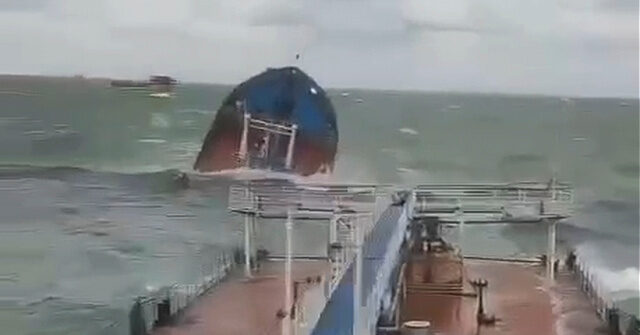Over the weekend, an environmental disaster unfolded in the Black Sea when two Russian oil tankers, Volgoneft 212 and Volgoneft 239, sank in the Kerch Strait, spilling thousands of tons of heavy fuel oil along 40 miles of the coastline. The incident prompted several coastal towns, including Anapa— a popular resort area— to declare a state of emergency due to the extensive damage from the oil spill. Ukrainian President Volodymyr Zelensky condemned the situation, accusing Russia of causing irreparable environmental harm by operating outdated vessels in perilous weather conditions. He emphasized that these nearly 50-year-old ships should not have been allowed to sail, particularly in such treacherous waters.
The circumstances surrounding the spill were exacerbated by the severe weather in the Kerch Strait, which included 25-foot waves and winds reaching 45 miles per hour. The Volgoneft 212 broke apart in the storm, killing one crew member while two others remain missing. The Volgoneft 239, meanwhile, ran aground near the Russian village of Taman but was successfully evacuated. Together, these tankers were transporting mazut, a low-grade heavy oil that has limited use in Western countries due to its classification as “waste oil.” This type of fuel is extensively used in Russia and the former Soviet states, contributing to the severity of the spill that Greenpeace officials have estimated to involve at least 3,700 tons of oil.
This spill is not an isolated incident; it has drawn comparisons to a significant spill in 2007 that resulted in long-term environmental damage to the Kerch Strait region. Experts warn that the current spill may evolve into a more severe crisis as prevailing wind and ocean currents could worsen the situation. Greenpeace Research Laboratories’ chief, Dr. Paul Johnston, highlighted that in such conditions, containing and cleaning up oil spills becomes exceptionally challenging. The extent of the damage is evident, with reports of sea birds affected and residents struggling to breathe due to toxic fumes rising from the spill.
In further alarming developments, another Russian tanker, the Volgoneft 109, issued a distress call in the early hours of Wednesday, facing issues with a damaged cargo tank while also carrying 4,000 tons of mazut. Though Russian authorities downplayed the situation aboard the Volgoneft 109 as “not critical,” marine scientists, such as Sergey Stranichny, warned of ongoing leaks from the wreck of Volgoneft 212. Satellite imagery also shows the expanding oil spill affecting more areas, raising concerns among environmental advocates and local residents alike.
The picturesque beaches of Anapa, a city known for its golden sands, are at the forefront of cleanup efforts as local authorities grapple with the ongoing fallout from the spill. Approximately 4,000 volunteers in the region have joined forces with city officials and the Ministry of Emergency Situations to combat the contamination. However, cleanup operations face setbacks due to persistent harsh weather in the Kerch Strait, which complicates recovery efforts. Krasnodar governor Veniamin Kondratiev expressed concern over the unpredictable duration of the cleanup due to these unfavorable conditions.
Zelensky and other Ukrainian officials have continued their criticism of Russia’s maritime practices, highlighting the risks posed by the aging fleet used to transport hazardous material. The Ukrainian president likened the operational practices to negligence, accusing Russia of utilizing old and poorly maintained vessels to transport dangerous cargo—essentially endangering the environment and Ukrainian coastlines. Zelensky urged Western leaders to take action against this “shadow fleet” through sanctions and other measures. He argued that halting these operations could serve a dual purpose: disrupting Russia’s financing of the war and protecting the natural environment from future disasters.

